Hecate: Triple-Bodied Greek Goddess of Witchcraft and Keeper of Keys
Hecate the goddess of Greek mythology has been primarily remembered for her associations with magic and witchcraft. Throughout history however, her sphere of influence also included the moon, night, crossroads, boundaries, ghosts and necromancy. Although Hecate was once considered to be a powerful Greek goddess of witchcraft, Hecate was not a major deity when compared, for instance, to the Twelve Olympians.
There are therefore few myths which revolve around this Greek goddess of magic. Nevertheless, the goddess Hecate plays a particularly important role in the Greek myth which relates the abduction of Persephone. It is also from this myth that the quintessential representation of Hecate, as a goddess holding a flaming torch in each hand, is derived.
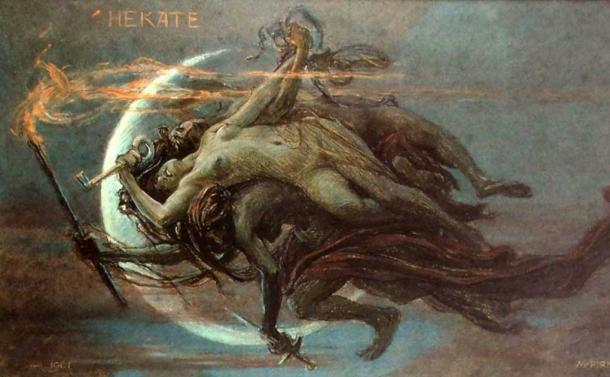
Painting of the goddess Hecate of Greek mythology, a.k.a. Hekate, by Maximilian Pirner. (Public domain)
The Powers of Hecate, the Greek Goddess of Witchcraft
It is generally believed that the goddess Hecate was the daughter of Perses and Asteria, both of whom were from the second generation of Titans. Nevertheless, some have claimed that she was the daughter of Zeus and either Hera or Pheraea. Yet others have stated that she was a daughter either of Leto or of Tartarus.
In any case, it is widely accepted that Hecate the goddess was not originally a member of the Greek pantheon. In fact, her cult is said to have originated in ancient Thrace, or perhaps in Caria, Anatolia. The original worshippers of Hecate believed that the goddess had power over heaven, earth, and the seas, thus making her an incredibly powerful goddess.
Hecate, whose name came from the Greek word hekatos meaning “worker from afar,” had the power not only to bestow upon those she favored wealth, good fortune, and wisdom, but also to withhold these gifts from those she perceived as unworthy. She was honored by all the gods, including Zeus. As she sided with the Olympians during the Titanomachy, she was the only member of the old regime who retained her powers following the defeat of the Titans.
Within ancient Greek religion Hecate had many different roles, as goddess not just of witchcraft, but also of magic, spells, the night, ghosts, light, necromancy, and even the moon. She was also seen as a goddess of oikos, meaning the household and family, and doorways. Some have even connected her to Artemis, who was portrayed in a similar style, with boots, torches and dogs.

A modern representation of a triple-formed Hecate holding torches and accompanied by black dogs. (mari-na / Deviant Art)
Due to her extensive powers, Hecate has been confused and identified with several other deities throughout history. For instance, as a goddess of nature, she was identified with Demeter, whilst as a moon goddess, she has been identified with Persephone.
"I am she that is the natural mother of all things, mistress and governess of all the elements, the initial progeny of worlds, chief of powers divine, Queen of heaven, the principal of the Gods celestial, the light of the goddesses: at my will the planets of the air, the wholesome winds of the Seas, and the silences of hell be disposed; my name, my divinity is adored throughout all the world in divers manners, in variable customs and in many names, [...] Some call me Juno, others Bellona of the Battles, and still others Hecate. Principally the Ethiopians which dwell in the Orient, and the Egyptians which are excellent in all kind of ancient doctrine, and by their proper ceremonies accustomed to worship me, do call me Queen Isis." (Lucius Apuleius in The Golden Ass)
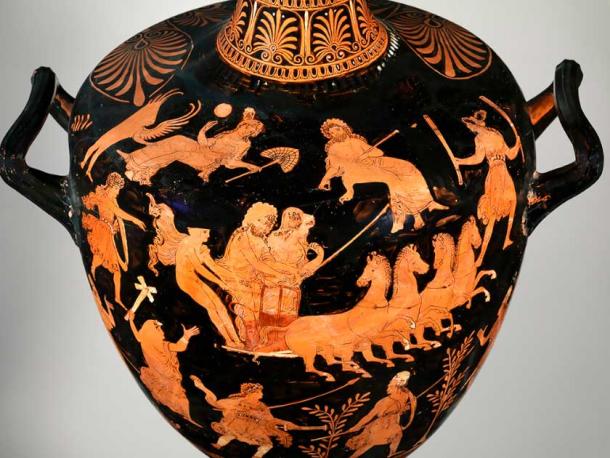
Terracotta water jar from circa 340 to 330 BC depicting the abduction of Persephone by Hades, surrounded by gods, including the torch-bearing Hecate in the top right. (Public domain)
Who is Hecate within Greek Mythology?
“Hecate, whom Zeus son of Kronos honored above all others, granting her magnificent privileges: a share of both the earth and of the undraining sea. From the starry heaven too she has a portion.” (Hesiod - Theogony)
Unfortunately, there are not many Greek myths about the goddess Hecate. She was first mentioned within Hesiod’s 8th century Theogony. Since there was little mention of her before Theogony, some academics have argued that the ancient Greek poet was from a town where Hecate had a substantial following and that his writing helped to promote her cult.
The Greek goddess Hecate is also mentioned in the myth of Persephone’s abduction by Hades. In fact, she plays an important role in this tale. Hecate is mentioned in Homer’s version of the myth, which is known as the Homeric Hymn to Demeter, her most famous literary manifestation which was written in 600 BC.
According to the poet Homer, Hecate was the only deity, apart from the sun god Helios, who witnessed the abduction of Persephone. Therefore, when Demeter, the goddess of agriculture and Persephone’s mother, began the search for her daughter, Hecate accompanied her with a flaming torch in each hand. After Persephone was found, Hecate became her companion and attendant. During the time of the Greek tragedians, the notion that Hecate was a chthonic, or underworld, deity due to her association with Persephone became common.
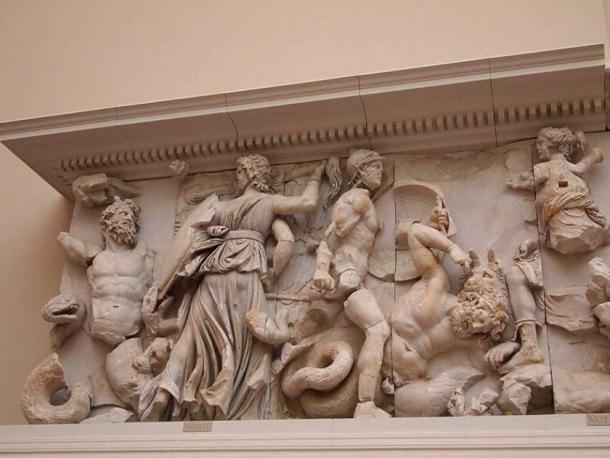
Hecate battling Clytius with a torch, a sword and a lance on the Gigantomachy frieze created in the 2nd century BC in Pergamon and reconstructed at the Pergamon Museum in Berlin. (Miia Ranta / CC BY-SA 2.0)
Hecate is also included in Greek mythology related to the Gigantomachy. Here legend had it that she fought alongside the Olympians and killed Clytius the giant using her famed torches. This story was so much entrenched within collective consciousness that the goddess Hecate is depicted fighting against Clytius alongside Artemis on the Pergamon Altar, within the Gigantomachy frieze.
In another legend, Hecate was associated with a black dog said to have once been the Trojan queen Hecuba. The wife of the Trojan king Priam at the time of the Trojan War, she ended up going mad and leaping into the sea when she was taken as a slave. The story claims that the goddess Hecate took pity on her and tuned her into a dog who then became her companion.
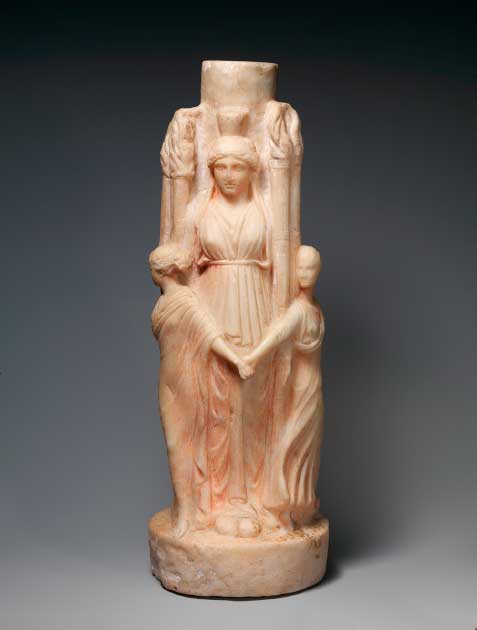
1st to 2nd century AD Roman marble statuette of triple-bodied Hekate and the three graces. Shrines to Hecate were included at doorways or within home shrines. They were sometimes known as Hekataion. (Public domain)
The Goddess Hecate in Art
It was due to this myth that the typical image of Hecate in artwork was formed. Initially, she was represented as a single-formed goddess in a long robe. In each of her hands, the goddess held a flaming torch, a clear reference to the role she played in the myth of Persephone’s abduction. While she is most frequently portrayed holding a pair of torches, she is often depicted with snakes, a key, or even with dogs.
The earliest representation of the goddess Hecate discovered so far dates back to the late 6th century BC and was discovered in Athens. Inscribed with the words “Aigon dedicates this to Hekate,” this small, 20 cm (7.87 in) terracotta votive statue portrayed Hecate as a seated woman wearing a crown.
Later on, however, she was represented as a triple-formed goddess. In these depictions, Hecate has three bodies that stood back-to-back, and it has been speculated that this was meant to allow the goddess to look in all three directions simultaneously. This concurs with her role as a deity in charge of crossroads or boundaries. In fact, Hecate was protector of all “in between” spaces, ranging from city walls and territorial borders to doorways.
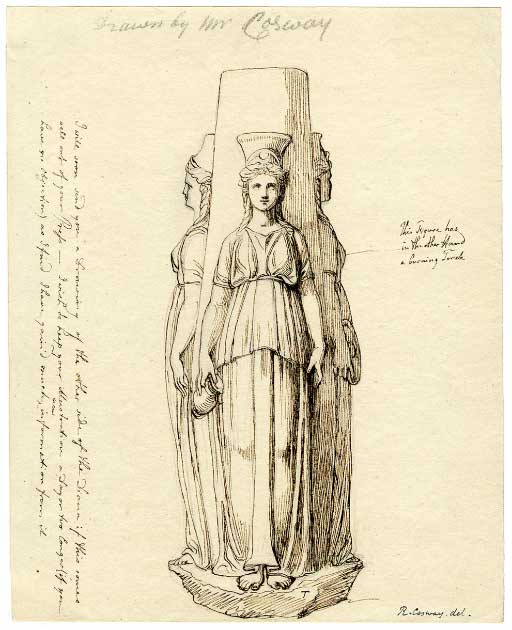
Drawing of a Hecate statue by Richard Cosway. (The British Museum / CC BY-NC-SA 4.0)
It is also due to this role that pillars, or large Hekataions, were erected at crossroads and city gates. One was even included at a crossroads near the Acropolis. Such pillars also stood at doorways and likely served an apotropaic function, with the power to ward off evil. On earlier pillars, the goddess Hecate was depicted wearing a long robe and holding her habitual torches. Experts believe that this symbolized her ability to keep away evil spirits.
On later pillars she was triple-formed, and often accompanied by dogs, allowing her to see in all directions at the same time. Ritual offerings of food known as deipna were left for the goddess Hecate on the last night of the lunar month at crossroads, in the hope of appeasing the goddess and any restless dead accompanying her. Some accounts record dogs were also sacrificed to Hecate.
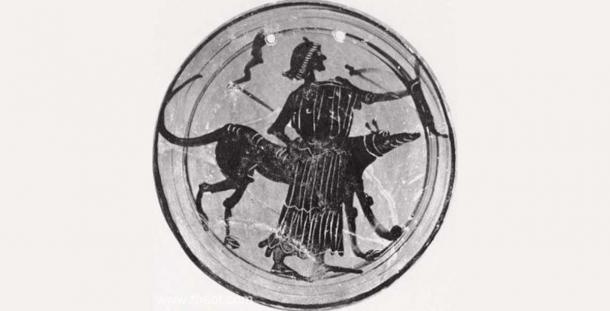
Hecate, depicted with a bow, twin torches and a dog on an attic black figure kylix. (Public domain)
As an in-betweener, she also played a role at the border between life and death. In many depictions she is shown with keys, used to unlock the gates that divided the two realms. Hecate’s Grove was a term used by Virgil to describe the entrance to hell, while the Greek Magical Papyri claimed that Hecate held the keys to Tartaros in the underworld. This was an exceptionally powerful role, as a goddess able to move between the living and the dead and control the destiny of others.
Hecate’s power was eventually reduced and her sphere of influence became far more specific. Over time, her role as a protector morphed until she was represented more clearly as a triple-bodied goddess of magic and witches, haunting crossroads alongside her hellhounds, believed in some accounts to be restless souls.
As a result, she is best remembered as a mystical Greek goddess of witchcraft associated with magic and sorcery. This transformation of Hecate has been traced to 5th century Athens. These days the goddess Hecate, or the Triple Goddess, has become an archetype within the pantheon of modern-day Neopagans.
- Curious and Unusual Spells from the Greek Magical Papyri
- Dark Sketches & Stories from the Underworld in Greek Mythology
In the works of the 4th century tragedians Sophocles and Euripides, Hecate was depicted as a goddess of witchcraft, whilst just a century earlier, she was depicted as a much more powerful and amplified goddess, as seen in the works of Aeschylus. Her role is further reinforced by the fact that she is the goddess who is mentioned most frequently in magical texts, for instance, the Greek Magical Papyri, as well as on ancient Greek curse tablets.
Top image: Hecate sculpture at Antalya Archaeological Museum in Turkey. Source: neurobite / Adobe Stock
By Wu Mingren


















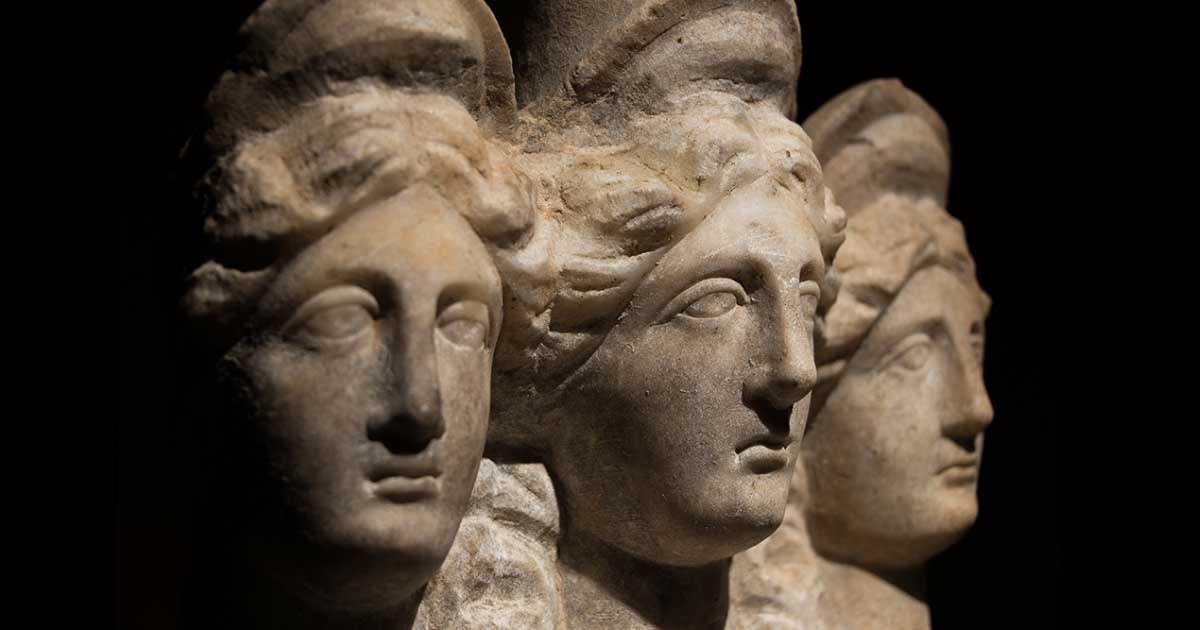

Comments
She held the keys, the annointed one took them. When the great "god" pan died when the earthquake shook the temple... Interesting tho that she was tripartate... Did she perhaps have a piece of technology that allowed her to literally duplicate herself? Or did ahe conglomerate with 2 other godesses ala potara fusion? But werent Prometheus and Epimetheus titans? She couldntve been the only one.. her association with demeter and artemis.. the tripartate nature... I love the greeks version of the 3rd age. Again.. the stories are so similar.. modified for cultural quirks.. yet why is thats so hard to accept as a possibility? Its just a myrh a story .. ignorant mans attempt to explain the way things work thrutheir faith in the created dietys domain... But what if its ignorant mans history?.. each of these gods and goddesses a slave pawn food source and occasionally a sex toy.. if you accept bible as history.. everything else notwithstanding (certainly enough archeological evidence to convince me) then there is no reason these myths might also hold kernels of truth, and self understanding.. if we were ,all races, created as a relatively idiotic 2nd draft... Why should we hate each olher and fear each other? Each of the 7 fallen(elohim) had their own empires and implanted the genetic memory to hate what isnt similar? Y gold lust unless imprinted again within the chimaeric dna experiment so as to mine tiamats veins for them? Y even the need for a higher power unless the god expiernce portion of the brain that certain hallucinations and project bluebeam stimulates was again placed there so this homo sapiens wouldnt rebel and destroy the moon domes of igigi like krishna and the other atlanteans(1st man, cromagnon) but this is all just useless speculation.. unless their brown dwarf planet indeed does return in the next few deaces to a century.. if chernobyl wasnt also the 4th trumpet. P.s. i dont think my theiry is too far fetched after the artefact rape of the middle east by the us 3 letter agencies.. or after reading clintons email about gilgameshs immortality machine.. or how the treads connect.. but ahain.. ive yet to see any proof that im wrong.. n lots that i might be close to truth... Tangental exposition finis
infinitesimal waveparticles comprise what we call home the earth
manipulatable by thought ability supressed in humans since birth